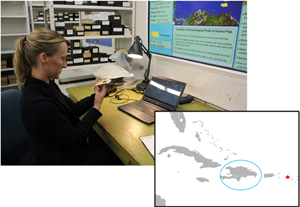Michelle J. LeFebvre
Ph.D., 2015, University of Florida

I am an anthropological and environmental archaeologist with a focus in zooarchaeology. My research draws on a combination of traditional zooarchaeological analysis, chemical and genetic analyses of bone, as well as patterns of past settlement and site configurations to better understand the myriad ways past people interacted with animal populations and the environment. Of particular interest to me are the ways in which people negotiated and managed the inherent link between environmental parameters and social conditions through animal procurement, access, consumption, and use. Geographically and temporally, my primary foci include the pre-Columbian Ceramic Age of the Caribbean islands and the Woodland period in the Southeastern United States.
Currently, I am a post-doctoral researcher with the ERC-Synergy Project NEXUS 1492, directed by Corinne Hofman at the Faculty of Archaeology, University of Leiden, The Netherlands. In collaboration with the Caribbean Archaeology and Environment Archaeology Programs, I conduct my research at the Florida Museum of Natural History, where I am a Courtesy Research Scientist with the Anthropology Division. As a part of NEXUS 1492, my research addresses how indigenous groups of the later Caribbean Ceramic Age (AD 500-European Contact ca. 1500) incorporated and used animals within multi-scalar networks of interaction and variable forms of social complexity. My goal is to gain a better understanding of the social and environmental landscape of the Caribbean islands and people on the proverbial eve of European colonization, ultimately contributing to a more holistic and contextualized understanding of Caribbean history and cultural heritage through time. Specifically, I am conducting intra-site zooarchaeological analyses of faunal materials from El Cabo, a large village site located in the Dominican Republic, the Kelbey’s Ridge 2 site, a small village located on Saba, and the historic component (ca. 1492) of En Bas Saline located in Haiti. The results of zooarchaeological analysis will provide a basis for assessing degrees of variability in faunal deposition, taphonomy, site layout/use, and environmental exploitation within and between the different sites; revealing how social interactions and shared cultural links did or did not manifest in terms of local foodways and traditions of animal procurement, use, and consumption among people within and between socially and environmentally diverse sites and islands.